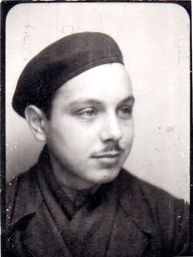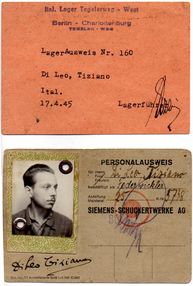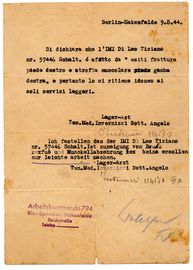Tuesday, 29 May 1945
Return to Italy: Tiziano Di Leo
"Bernau. The French, prisoners of war and civilian workers, left this evening for home. Freight trains have arrived to pick them up and take them to the Elbe River, where the Americans are waiting for them. Our neighbours, the nine Frenchmen from the accommodation next door, also set off with a lot of noise. For them now the last part of this 5-year odyssey begins. A long and arduous odyssey, just like for us Italians. The last stage of sacrifice begins, but they are happy to go home. They will have to sleep on straw for a few more nights in the face of chaos, but what the heck. It's going home now... I talked to them by candlelight until midnight last night. We talked about our homeland, about returning home soon, about home, about our mothers. They told us about Paris with an enthusiasm and passion with which they could have infected everyone... They gave me their addresses and I will certainly write to them: In memory of the brief friendship we had formed after liberation."
(From the diary of the former Italian forced labourer Tiziano Di Leo)
Tiziano Di Leo was born on 19 November 1920 in Turin. After Italy left the war, the young recruit experienced the occupation of northern Italy by the Wehrmacht on September 9, 1943. In Ancona, Di Leo, like hundreds of thousands of other Italians who refuse to continue to fight for fascism, falls into German captivity. Di Leo is taken in a cattle car to the Stalag III A collection camp near Luckenwalde. Here he has to undergo a medical examination and is finally assigned to forced labour as a lathe operator at the Siemens-Schuckertwerke in Berlin-Spandau. On September 15, 1943, Di Leo reaches the Salzhof labour camp. After a bomb hit, however, he is transferred to Camp 159 in the Spandau Reichsstraße. The living conditions in the camp are harsh and basic food is lacking. Under guard, Di Leo and his work detachment must march daily from Spandau-Hakenfelde to Siemensstadt, about 10 km away.
When the Soviet offensive on the Reich's capital began in spring of 1945, Di Leo noted in his diary: "Berlin is going to its knees! The Italians hope for an early end to the war. But Di Leo is taken to Müncheberg, where he is to set up anti-tank barriers with other prisoners. In the face of the advancing Red Army, he must return to Berlin on April 18, this time to the "Italy Camp" on Tegeler Weg near Jungfernheide station. Here Tiziano Di Leo experiences the liberation by the Red Army on April 26.
Through the destroyed Berlin, the liberated Italians are first brought to an international collection camp in Wittenau. Many of them try from here to set off on their own to their homeland. When Soviet troops announce that the camp in Wittenau is needed for military purposes, Di Leo has to move on again. Together with about 500 other liberated men - Italians, French and Dutch - Di Leo is transferred to Bernau on May 8. In his diary he notes: "Half of Bernau has been cleared by Germans. The beautiful Art Nouveau villas are occupied by Russian women. Out of the blue, a Russian village has sprung up here. When you walk between the villas, your mouth is open: so many different colours, colourful skirts, clothes of every fashion... They all suffered so much and now they enjoy life... Most of them had to work under constant bombardment with shovels and pickaxes, they were treated like slaves. Now it's all just a memory for them."
On June 1, 1945, Tiziano Di Leo left Bernau, first in the direction of Buckow (Märkische Schweiz), where about 20,000 former Italian forced laborers were already waiting to go home. With a handcart he finally reaches Müncheberg. He can continue his journey to Italy by freight train. On September 4, 1945 Tiziano Di Leo reaches his home town of Fabriano.
(Source: Tiziano di Leo, "Berlino 1943 - 1945. Diario di Prigionia," published by Centro Studi don Giuseppe Riganelli, Fabriano: 2000; Photo material: Di Leo family, thanks to Gianfranco Ceccanei for the collection)


